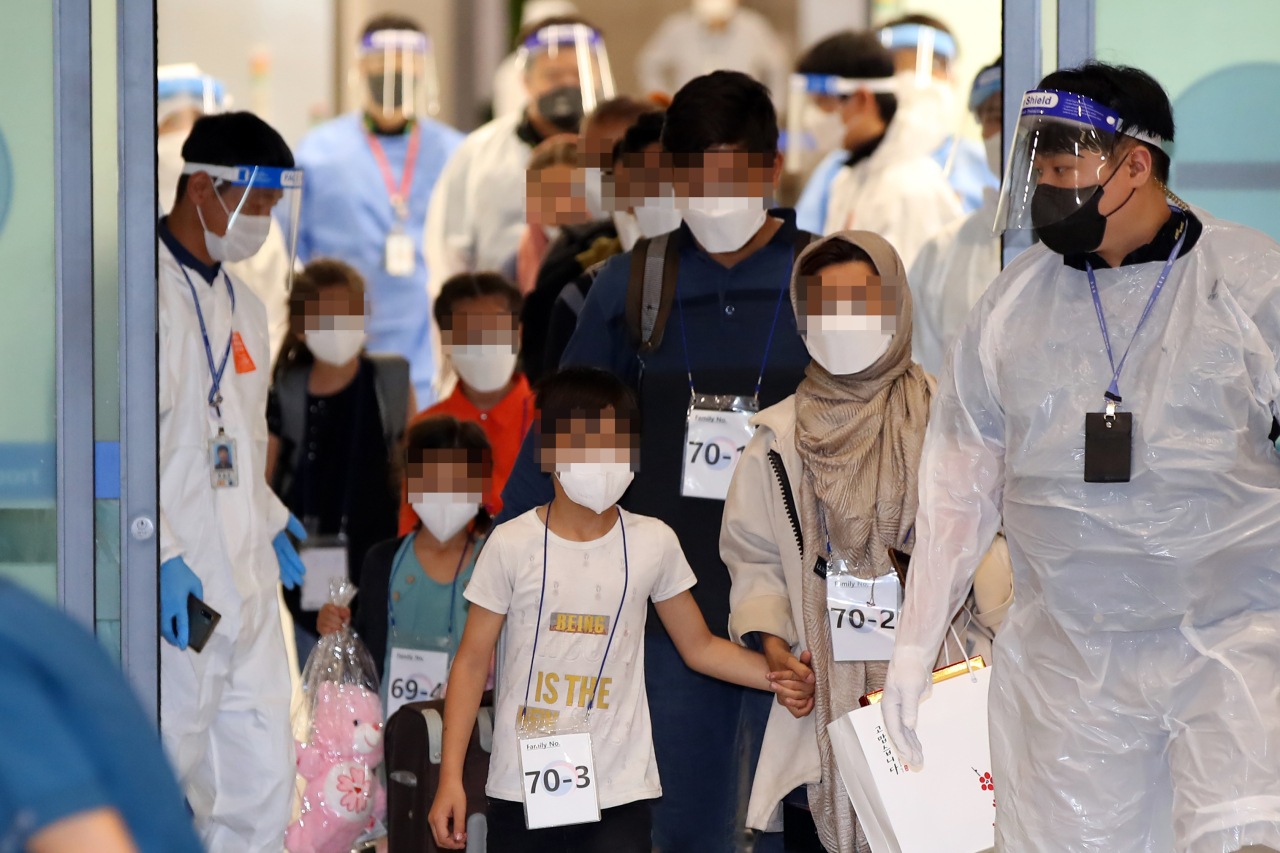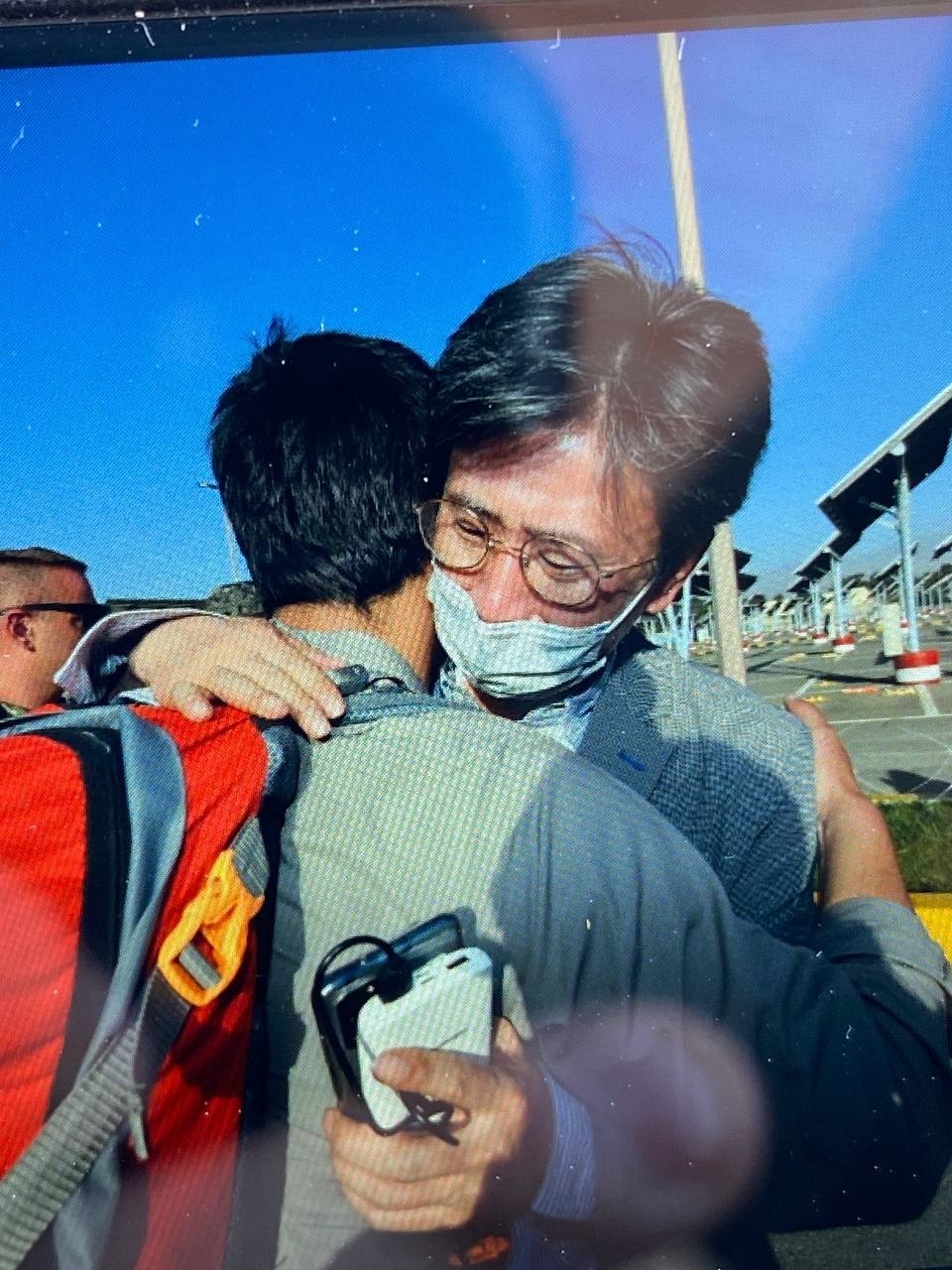
The second and final group of Afghan evacuees who worked alongside the South Korean government arrived here on Friday, as part of Seoul’s mission to rescue civilians fleeing the war-torn country following the Taliban takeover.
The group of 13 Afghans onboard a C-130 military jet landed at Incheon International Airport at around 1 p.m., after leaving the Pakistani capital of Islamabad on Thursday, according to the Foreign Ministry. Their arrival came a day later than the first group of 377 evacuees who arrived here Thursday –- due to a lack of space on the first flight.
The latest arrivals were tested for COVID-19 at the airport and will wait in a separate accommodation near the airport until the test results are back. Those who are confirmed negative will head to a government-designated facility in Jincheon, North Chungcheong Province, joining other evacuees who arrived there Friday.
They are expected to stay at the facility for six to eight weeks, including the two-week mandatory self-quarantine.
In the rescue mission code-named “Operation Miracle,” South Korea dispatched three military jets earlier this week, a KC-330 tanker and two C-130 planes. They transported a total of 390 Afghan “allies” -- those who worked with Korean entities and their families -- who are vulnerable to potential Taliban reprisals for working with foreign governments.
The evacuees are translators, medical personnel, engineers and staffers who have worked for years with the Korean Embassy in Afghanistan, as well as Korea-led reconstruction efforts, including at hospitals, vocational training centers and provincial reconstruction teams.
About half, or around 180, of the total evacuees are under the age of 10, including 100 infants. They make up a total of 76 families.
Seoul’s unprecedented mission to airlift 390 Afghans out of the country under the new Taliban rule came with many difficulties as the situation on the ground was growing more precarious by the day.
On Thursday, two suicide bomb attacks outside of Kabul Airport killed at least 13 American servicemen and 60 Afghans. The explosions, which were claimed by the terrorist organization Islamic State’s regional affiliate, caused further chaos in the country, disrupting the final days of the US-led evacuation effort.
The Abbey Gate, a main entry point to the airport that was the site of an explosion, was the same passage South Korea used just few days earlier for some 26 Afghan evacuees to arrive at the airport, a source said Friday.
On Monday evening, Seoul officials in Kabul are said to have received intelligence on possible terrorist attacks around the airport. So they had to find other ways for to bring the Afghans safely inside the airport and speed up the evacuation process.
But access to the airport has been limited, with armed Taliban forces heavily guarding checkpoints to stop Afghans from fleeing the country. So later in the week, the South Korean government was able to arrange a bus service to bring Afghans in to the airport from two designated meeting points close by.
Kim Il-eung, minister counselor of the now-closed South Korean Embassy in Kabul, recalled the strenuous evacuation process, which included Afghans stranded inside the bus fearing that they might not able to make it to the airport.
“The Afghans were stuck inside the bus for around 14 to 15 hours at the gate of the airport because the Taliban didn’t allow them in,” Kim said in a virtual interview with reporters on Friday. “The people were inside the bus with their children, with no air conditioning and they couldn’t see anything outside through the darkly tinted windows. They were waiting anxiously, not knowing what was happening and worried that they might be forced to return.”
But when the bus finally arrived at the airport early morning Wednesday, he felt relieved to meet the evacuees, which included some coworkers whom he worked at the embassy.

Kim was part of the small group of officials and security guards, who flew back to Afghanistan to carry out the arduous mission, after all embassy staff evacuated to Qatar last week when the Korean Embassy in Kabul closed down following the Taliban takeover of the country.
Kim said he had to return, because embassy officials on the ground were needed to manage logistics and confirm identification of the Afghan evacuees.
When he left Afghanistan earlier, Kim wasn’t sure how to and whether it will be possible to return to the country to evacuate his Afghan colleagues. “But I assured them that we will come up with ways to take them to Korea,” he said.
The Afghans, who entered here as “persons of special merit,” received short-term visas valid for up to 90 days. They will then be granted long-term visas later and eventually, they can apply for F-2 residential visa, which allows them to work here.
All arrivals underwent background checks before departure, but the government will verify their identities again while they are staying at the temporary shelter due to public concerns over security.
Seoul’s evacuation mission comes as the US and other countries are scrambling to evacuate their own citizens and Afghans, ahead of an impending Aug. 31 deadline the US has set to complete the withdrawal of its forces from the country.
The mission marks the first time that Seoul has evacuated a large group of locals from a conflict zone for humanitarian purposes.



















![[Today’s K-pop] Treasure to publish magazine for debut anniversary](http://res.heraldm.com/phpwas/restmb_idxmake.php?idx=642&simg=/content/image/2024/07/26/20240726050551_0.jpg&u=)